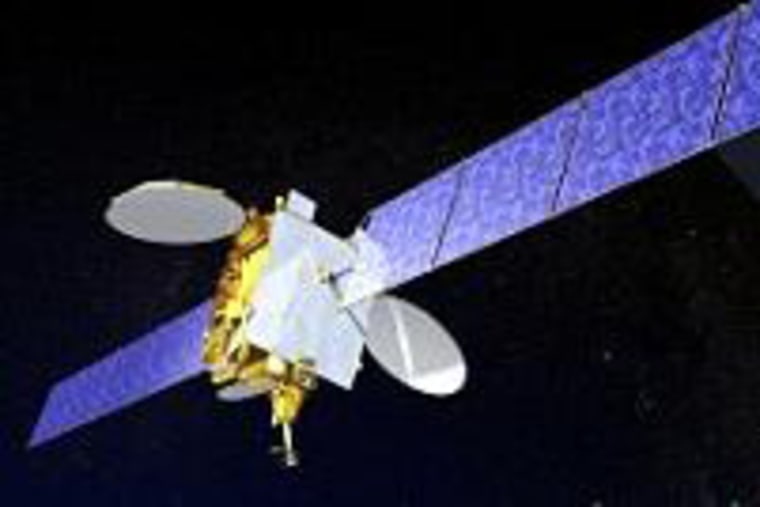An off-course communications satellite that a private team wanted to rescue and resell has instead been steered to its destruction in Earth's atmosphere, according to the Defense Department and amateur satellite watchers.
The satellite, ArabSat 4A, was launched by a Russian rocket on Feb. 28 but wound up stuck in an orbit lower than its operational altitude.
ArabSat's situation was similar to that of Eight years ago, Asiasat 3, a communications satellite that was launched eight years ago toward a standard geosynchronous orbit over Earth's equator — only to be similarly stuck halfway due to a Russian rocket failure. In that earlier case, engineers came up with a bold scheme to steer Asiasat 3 deep into space and use the moon's gravity to change its orbit into a useful one.
This time, however, the hopes for space magic were dashed by the satellite's deliberate demise.
"We are disappointed," said Dennis Wingo of Orbital Recovery, whose group had coordinated the development of a rescue plan. "But we understand the operators' concerns."
Other participants in Wingo's group included Cesar Ocampo from the University of Texas at Austin, Mike Loucks from Space Exploration Engineering, John Carrico from Applied Defense Solutions Inc. , Rex Ridenoure from Ecliptic Enterprises Corp. and veteran space engineer Gordon Woodcock.
Robotic tug nixed
As soon as ArabSat's predicament became known a month ago, Wingo and the other experts began working on plan similar to that used in 1998. They found that while there was not quite enough fuel on board for such a rescue mission, they could park the satellite in a convenient location where a robotic space tug, already under development by Orbital Recovery, could push it to a money-making orbit.
Neither the satellite's original owners nor the European insurance team — who assumed ownership once their client declared a "total loss" of the vehicle — turned out to be interested in attempting such a rescue. The satellite builder, EADS Astrium Aerospace in Germany, was told to send the destruct commands to the satellite on Thursday.
Maj. Jeff Jones, a spokesman for the U.S. Strategic Command, told MSNBC.com that ArabSat re-entered the atmosphere over the South Pacific at 9:07 p.m. ET Thursday. "Re-entry was confirmed by infrared sensors," he said.
Even before Jones' report, the absence of the satellite was noted by an informal network of highly skilled amateur satellite watchers who had been monitoring ArabSat since its launch. Texas observers Mike McCants and Ed Cannon reported that they missed spotting ArabSat under conditions that should have yielded a clear sighting.
Variety of proposals
During the month that ArabSat 4A circled Earth in its intermediate orbit, planners on Earth came up with a variety of proposals for salvaging a useful mission even if it could not reach the intended geosynchronous orbit. Since the spacecraft contained a significant amount of rocket fuel, it had more than enough to reach the moon, or even head for interplanetary space.
The problem was, as a communications satellite it had no scientific instrumentation, and its communication system was not designed for lunar distances. Nevertheless, imaginative orbital designers studied flight paths that would place the satellite into lunar orbit — or even into one of the "gravity-neutral zones" in the Earth-moon system. One orbit that would have ranged behind the moon was suggested for a stationkeeping demonstration, to obtain experience in operating a communications relay to support future human missions to the moon.
ArabSat was also considered for a close flyby over the lunar surface, where its radio transmitter could function as a makeshift radar sounder to seek hints of ice in the bottoms of lunar polar craters. Alternately, the 3-ton spacecraft could have been aimed to impact directly inside one of the suspect craters, allowing other spacecraft to look for water vapor in the ejected debris.
None of these missions interested the satellite owners, however, and their urgent cash-flow requirements frustrated several attempts to obtain private transition funding for operations.
Would-be rescuer Wingo was philosophical: "Every time a satellite is left in a stranded orbit," he told MSNBC.com, "an opportunity is lost to save it" for its original purpose or an alternate aim.
Perhaps, he speculated, the next time a communications satellite is stranded — and there will be a next time — a well-defined menu of alternate missions and alternate emergency funding will be available.
